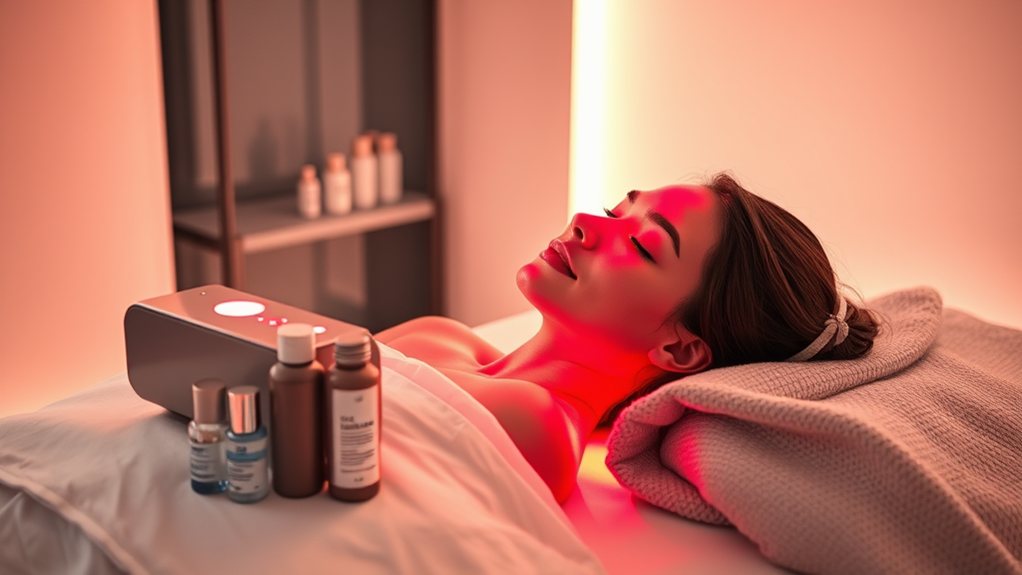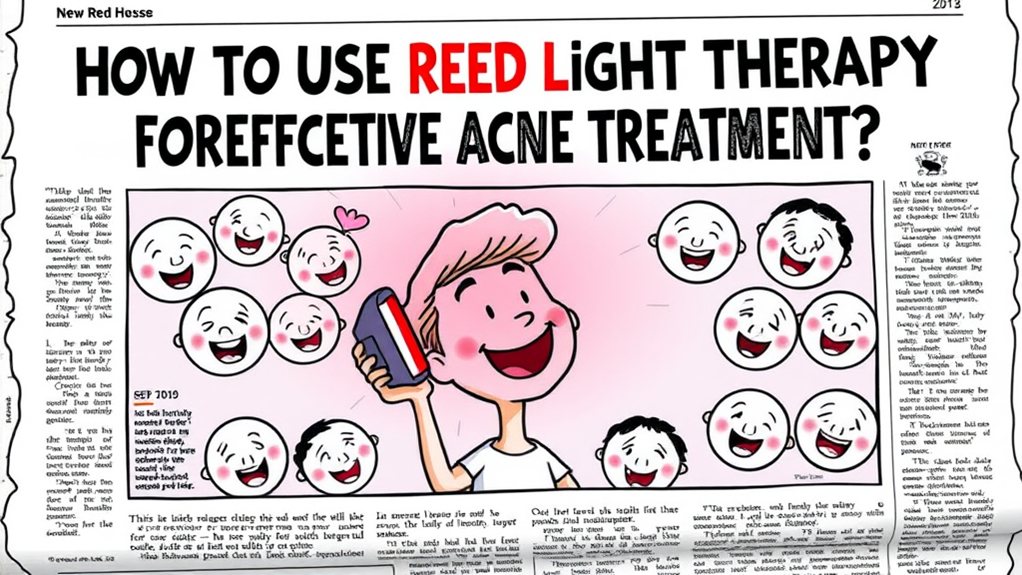In order to use red light therapy effectively for acne, start by a gentle cleansing routine in order to prepare your skin. Position the device 6 through 12 inches from your face, targeting affected areas for 10 through 20 minutes per session. Keep your eyes closed or use protective eyewear. Post-treatment, apply a soothing moisturizer in order to hydrate your skin. This non-invasive method promotes healing, reduces inflammation, and balances oil production. Discover additional tips to improve your results moving forward.
Key Takeaways
- Cleanse your skin thoroughly with a gentle cleanser before each session to remove impurities and minimize irritation.
- Position the red light therapy device 6 to 12 inches from your face, targeting acne-prone areas.
- Use the device for 10 to 20 minutes per session, allowing the light to penetrate effectively.
- Keep your eyes closed or wear protective eyewear during treatment to ensure safety.
- Apply a soothing, non-comedogenic moisturizer after each session to hydrate and support skin recovery.
Understanding Red Light Therapy and Its Benefits for Acne

Red light therapy (RLT) is an innovative treatment gaining popularity for its effectiveness in managing acne. This non-invasive approach harnesses the power of red light wavelengths to target the underlying causes of acne, promoting skin healing and reducing inflammation.
Many individuals have experienced significant acne benefits, including reduced blemishes and improved skin texture. RLT stimulates cellular activity, enhancing collagen production and accelerating tissue repair, which can lead to clearer skin over time.
Studies suggest that regular sessions can also help balance oil production, further preventing future breakouts. If you're looking for a supportive community focused on effective skincare, contemplating RLT could be a step towards not just clearer skin, but also a boost in your confidence.
How Red Light Therapy Works on Acne-Prone Skin
Using red light therapy on acne-prone skin involves specific mechanisms that target the underlying factors contributing toward breakouts.
The mechanism explanation centers on how red light penetrates the skin, promoting cellular repair and reducing inflammation. This process improves skin absorption of light energy, which stimulates collagen production and aids in healing acne lesions.
Additionally, red light therapy can decrease sebum production and combat the bacteria responsible for acne, further preventing future breakouts.
Red light therapy effectively reduces sebum production and targets acne-causing bacteria, helping to prevent future breakouts.
Clinical studies support these effects, showing significant improvement in skin clarity and texture after consistent use.
Choosing the Right Red Light Therapy Device

When selecting a red light therapy device for acne treatment, it's crucial to take into account factors such as wavelength, intensity, and treatment area coverage.
Different device types, including handheld units, masks, and panels, cater to various needs. For effective results, look for devices that emit wavelengths between 600-650 nm, as this range has shown promising outcomes in clinical studies.
Additionally, contemplate the intensity; higher wattage devices typically provide quicker results. Effective brands like Joovv and LightStim are known for their quality and efficacy, making them popular choices among users.
Ultimately, ascertain the device fits your skin's specific needs and lifestyle, fostering a sense of belonging to a community that values effective acne treatment solutions.
Preparing Your Skin for Red Light Therapy
Before starting red light therapy for acne, preparing your skin helps maximize the benefits of treatment.
First, establish a consistent cleansing routine to remove dirt, oil, and impurities. Use a gentle cleanser suited for your skin type to minimize irritation and maintain hydration.
Establish a consistent cleansing routine with a gentle cleanser to remove impurities and keep your skin hydrated.
If you've recently introduced new skincare products, be mindful of potential skin sensitivity; contemplate patch-testing to avoid adverse reactions during therapy.
Exfoliation can also play a role, but avoid aggressive scrubs right before treatment to prevent any irritation.
Finally, make certain your skin is free of makeup and topical treatments that could interfere with the therapy.
Step-by-Step Guide to Using Red Light Therapy

To effectively utilize red light therapy for acne treatment, follow these essential steps to guarantee ideal results.
First, cleanse your skin gently to remove impurities.
Next, position the red light device approximately 6 to 12 inches from your face, ensuring it targets the affected areas directly.
Turn on the device, and allow it to emit light for the recommended duration, typically around 10 to 20 minutes per session.
Maintain your eyes closed or use protective eyewear to safeguard against potential irritation.
After the session, apply a soothing moisturizer to hydrate your skin.
Finally, observe how your skin responds over time, adjusting frequency as necessary to optimize the benefits of red light in your acne treatment routine.
Recommended Treatment Frequency and Duration
While individual skin types and acne severity can vary, most experts recommend using red light therapy sessions two to three times per week for best results.
Establishing the right treatment intervals and ideal duration is essential for achieving effective outcomes. Here are some guidelines to take into account:
- Session Length: Aim for 10 to 20 minutes per session.
- Consistency: Stick to the recommended frequency; consistency improves results.
- Monitoring Progress: Keep track of your skin's response to adjust treatment intervals if necessary.
- Rest Periods: Allow your skin to rest between sessions to maximize healing and prevent irritation.
Following these recommendations can help you harness the benefits of red light therapy for clearer skin and overall confidence.
Combining Red Light Therapy With Other Acne Treatments
Combining red light therapy alongside other acne treatments can boost overall effectiveness, allowing you in targeting multiple aspects of acne pathology.
This holistic approach not only addresses inflammation but also promotes healing and reduces scarring.
For instance, pairing red light therapy with topical retinoids can improve skin cell turnover and prevent clogged pores, while antibiotics can combat bacterial growth.
You might also think about integrating salicylic acid to exfoliate and keep pores clear.
By combining treatments, you're not just treating symptoms; you're working on underlying causes for more sustainable results.
Always consult a dermatologist before starting any new regimen to verify that the combination aligns with your unique skin type and needs, fostering a supportive environment in your journey toward clearer skin.
Potential Side Effects and Precautions
When integrating red light therapy alongside other acne treatments, it's important to be aware of potential side effects and necessary precautions.
While generally regarded safe, some individuals may experience mild side effects. To guarantee a positive experience, follow these safety precautions:
- Consult a dermatologist before starting treatment to assess suitability.
- Start with shorter sessions to gauge your skin's reaction and avoid overexposure.
- Monitor for unusual reactions like excessive redness or irritation, and discontinue use if they occur.
- Avoid using on broken skin or active infections, as this may worsen your condition.
Success Stories: Real-Life Results From Red Light Therapy
Red light therapy has garnered attention for its promising results in acne treatment, alongside many individuals reporting significant improvements in their skin.
Success stories highlight how users experience reduced inflammation and fewer breakouts after consistent use. For instance, one user testimonial shared that their acne cleared noticeably within weeks, boosting their confidence and overall well-being.
Another individual remarked that red light therapy not only improved their complexion but also improved their skin's texture.
These real-life results show that many people find relief from acne, fostering a sense of community among users.
As you evaluate this treatment, keep in mind that these positive outcomes reflect the potential of red light therapy in your journey towards clearer skin.
Maintaining Acne-Free Skin After Treatment
In order to maintain acne-free skin after red light therapy treatment, it's essential to adopt a thorough skincare routine and lifestyle changes that support long-term results.
Following these steps can help you achieve and sustain clear skin:
- Consistent Cleansing: Use a gentle, pH-balanced cleanser twice daily to remove impurities without stripping natural oils.
- Moisturization: Apply a non-comedogenic moisturizer daily to keep your skin hydrated and balanced.
- Sunscreen: Protect your skin with broad-spectrum sunscreen, as UV exposure can exacerbate acne.
- Healthy Diet: Incorporate a balanced diet rich in antioxidants and omega-3 fatty acids, which may help reduce inflammation.
Frequently Asked Questions
Can Red Light Therapy Worsen Existing Acne Symptoms?
Red light therapy can potentially cause temporary side effects, like increased redness or irritation. If you experience worsening symptoms, reflect on treatment adjustments. Always consult a professional to tailor your approach for best results and comfort.
Is Red Light Therapy Safe for All Skin Types?
Red light therapy is generally safe for all skin types, but individual skin sensitivity may vary. Short treatment durations can minimize adverse effects, ensuring a comfortable experience while maximizing benefits for your skin's health and appearance.
How Long Does It Take to See Results?
When it comes regarding visible improvements, you might find results after a few weeks of consistent treatment. Typically, a treatment duration of 10 until 20 minutes, several times a week, yields the best outcomes.
Can I Use Red Light Therapy on Active Breakouts?
Yes, you can use red light therapy on active breakouts. It promotes skin healing and reduces inflammation, acting as an active treatment. Just make sure you follow guidelines to maximize effectiveness and minimize irritation during sessions.
Are There Any Age Restrictions for Using Red Light Therapy?
There aren't strict age restrictions for red light therapy, but age factors are essential. Always follow treatment guidelines, especially for younger users. Consulting a healthcare professional guarantees safety and appropriateness for individual circumstances.
Conclusion
Incorporating red light therapy into your acne treatment regimen can yield impressive results, as evidenced by a case study where a 24-year-old woman saw a 70% reduction in breakouts after eight weeks of consistent use. By following the guidelines outlined in this article, you can harness the benefits of red light therapy in order to improve your skin's appearance. Remember, maintaining a proper skincare routine post-treatment is essential for sustaining your acne-free results.
